Sakura no baba:
A kingly grave of Matsuro is rediscovered after
sixty-three years.
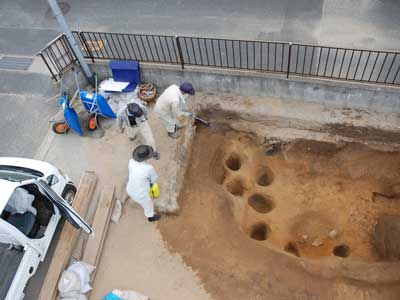
Investigation of a
kingly grave

Fragment recovered
in the current excavation
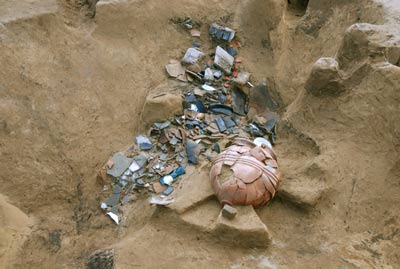
Pit with artifacts believed raked in while refilling the air raid shelter 
Naikō kamon mirror Late Yayoi, second century CE. Estimated diameter: 18.0 cm. A mirror made in Late
Han China. Plain-rimmed, the outer band has a combination of swirls,
straight lines, and arcs; the inner sector has a band with a series
of inward-facing concatenated arcs (naikō kamon), and an
inscription in which the characters 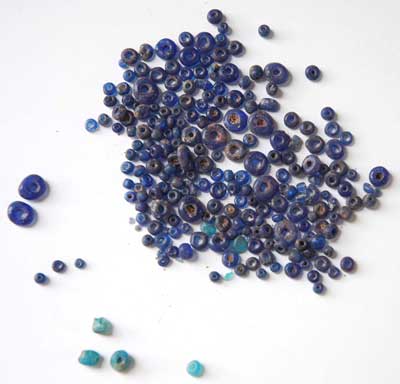
Small glass beads Late Yayoi, second century. Diameter: 3-6 mm. There were 2,500 recovered in the 2007 excavation. The discovery of such numerous small glass beads as funerary goods from the kingly grave is one of the significant results of the excavation. |

Locations of
ancient kuni in northern Kyushu
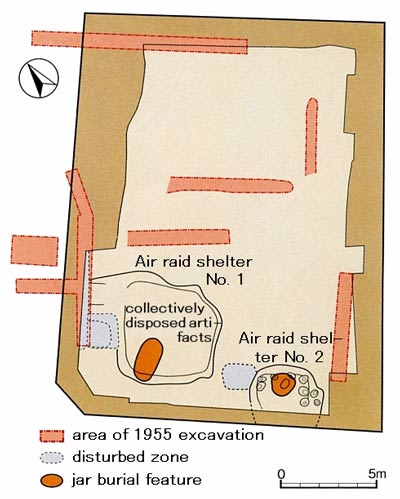
Distribution of
archeological features
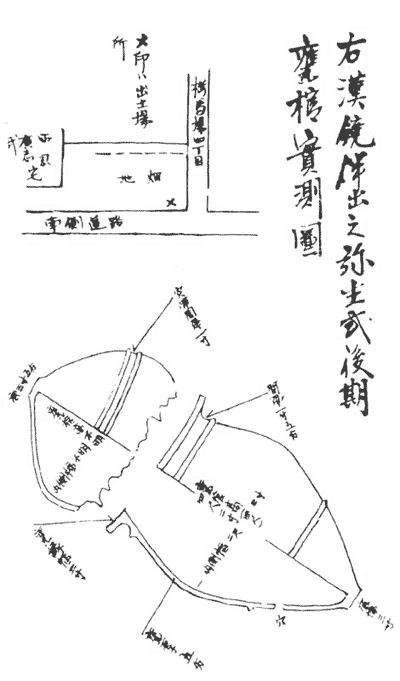
Drawings of the
site location and jar coffin
|
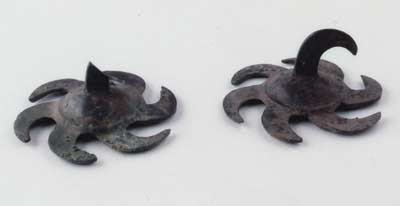 
Bronze whorl plaques Late Yayoi, second century. Diameter: 5.6 cm; height: 2.6 cm; 6 legs (both items). |
These are believed to have been made in the Japanese archipelago. The purpose of their manufacture and manner of use are unknown, but there are Kofun period examples that were mounted on shields, and to date more that 80 such items have been found. Those recovered from the Sakura no baba site have a prong attached to the top, and are precious as the only examples of their kind. The fragment in the box of the photo fits the 1944 find. 
An example of how bronze whorl plaques may have been used, based on items found mounted on shields of the Kofun period |
Photos courtesy of Karatsu municipal board of education, Saga prefectural museum,and Saga prefectural art museum.
An imaginary illustration by Yuka Tanaka.
Sakura no baba Site, Karatsu City, Saga Prefecture
Sakura no baba is a Late Yayoi period site located atop a sand dune overlooking Karatsu bay. When discovered in 1944, it stood slightly higher than the rice paddies on its south.
Discovery of a kingly grave
The investigation of Sakura no baba began in November 1944, when a Yayoi period jar burial was discovered during work to build an air raid shelter. As numerous bronzes including Chinese mirrors were included as grave goods, the burial was inferred as probably a kingly grave of the kuni (country, polity) of Matsuro. But the find was made under wartime conditions, and while the bronzes were taken for preservation, the jar itself was immediately reburied on the same premises.
The grave goods thus recovered, which were designated an Important Cultural Property, consisted of 2 Chinese Late Han mirrors of the TLV style, 26 barbed bronze bracelets, 3 bronze whorl plaques, 1 small glass bead, and 1 sword fragment.
In 1955 the vicinity was excavated by the Japanese Archaeological Association, but the location of the Matsuro kingly grave could not be ascertained.
An investigation was conducted as well in 1994 by the Karatsu municipal Board of Education, but once again the kingly grave could not be detected, and was considered to have been completely obliterated.
Rediscovery after sixty-three years
In 2007, the Karatsu Board of Education reinvestigated the site and located the air raid shelter, leading to the rediscovery of the kingly grave. A large number of bronze items were recovered from the air raid shelter.
Among these were fragments that fit a TLV mirror with a flowing cloud patterned rim, and a bronze whorl plaque, recovered in the 1944 excavation. Whereas it had been thought that the items found in 1944 comprised all of the grave goods, finds of the 2007 investigation were extraordinary in their quantity and quality: mirror fragments, bronze whorl plaques, small glass beads, cylindrical glass beads, cylindrical jasper beads, comma-shaped jadeite beads, and ring-pommeled swords.
With the addition of these newly discovered grave goods, the person buried at this location was recognized anew as a chief of particularly high status in Matsuro.
Moreover, as no archaeological features of the same age as the kingly grave have been found, the grave is seen to have been spatially isolated. Most likely, this kingly grave held special status.
What the Sakura no baba kingly grave indicates
The thirty-odd kuni described in the “History of the Kingdom of Wei” include Matsuro and Yamatai, but among these the location is known for only five: Tsushima (the modern city of Tsushima, Nagasaki prefecture), Iki (modern Iki, Nagasaki), Matsuro, Ito (in Maebaru, Fukuoka prefecture), and Na (in Fukuoka and Kasuga, Fukuoka). Sites which may be specified as kingly graves consist of Suku Okamoto, Mikumo Minami Shōji, Hirabaru, and Sakura no baba. Expectations are heightening for further investigations.
(Nitasaka Satoshi)